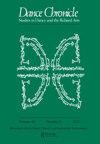体现灵活性:英国南亚舞蹈的美学与政治
IF 0.1
3区 艺术学
0 DANCE
引用次数: 0
摘要
阿努莎·凯达尔(Anusha Kedhar)的《灵活的身体》(Flexible Bodies)密切追溯了20世纪90年代至2010年代英国南亚舞蹈发展中的舞者和编舞家的生活和劳动。为了讲述英国南亚舞蹈的故事,Kedhar利用了她在伦敦的舞蹈生涯以及2004年至2017年间在英国和印度的民族志田野调查。Kedhar在对这一类型的研究中运用了民族志、民族志、舞蹈分析和政治经济学。英国南亚舞蹈是一种以其审美灵活性而闻名的音乐会形式。这种形式的指数融合了来自印度次大陆的古典、民间和武术习语的元素和动态,以及欧美现代和后现代的技术、舞台和制作。作为训练的一部分,他们培养南亚形式的灵活性(深弯、双手有关节、快速步法),同时培养与芭蕾舞和现代舞蹈技术相关的灵活性(尖头脚、伸腿、活动脊椎)。Kedhar将这一流派的出现与20世纪90年代以来英国多元文化主义的兴起联系起来,这就要求英国南亚舞者展示他们表演南亚和英国风格的灵活性。在多元文化主义的范式下,英国政府认为,打击前几十年的种族主义和种族主义暴力“只需要教育和提高对文化差异的认识,而不是真正的结构变革”(第11页)。英国决策者一致认为,促进包括舞蹈在内的少数民族和少数民族艺术可以促进民族融合。事实上,多年来,英国艺术委员会的支持在英国南亚舞蹈获得国际认可方面发挥了关键作用。Kedhar还分析了英国南亚舞者的灵活劳动,以及自20世纪70年代末以来新自由主义下“向劳动力灵活化的更广泛的经济和意识形态转变”(第2页)。在此期间本文章由计算机程序翻译,如有差异,请以英文原文为准。
Embodying Flexibility: The Aesthetics and Politics of British South Asian Dance
Flexible Bodies by Anusha Kedhar intimately traces the lives and labor of dancers and choreographers who were instrumental in the development of British South Asian dance between the 1990s and 2010s. In order to narrate the story of British South Asian dance, Kedhar draws on her time as a dancer in London and her ethnographic fieldwork in Britain and India between 2004 and 2017. Kedhar utilizes ethnography, autoethnography, choreographic analysis, and political economy in her study of this genre. British South Asian dance is a concert form well-known for its aesthetic flexibility. Exponents of this form integrate elements and dynamics of classical, folk, and martial dance idioms from the Indian subcontinent with Euro-American modern and postmodern techniques, staging, and production. As part of their training, they foster South Asian forms of flexibility (deep bends, articulate hands, fast footwork) while also cultivating the flexibility associated with ballet and contemporary dance technique (pointed feet, leg extensions, mobile spine). Kedhar charts the emergence of this genre in relation to the rise of British multiculturalism since the 1990s, which necessitated that British South Asian dancers demonstrate their flexibility to perform South Asianness and Britishness. Under the paradigm of multiculturalism, the British government assumed that countering racism and racist violence of the previous decades “simply required education and greater awareness of cultural differences rather than real structural change” (p. 11). British policy makers unanimously agreed that promoting ethnic and minority arts, including dance, could enable national integration. In fact, support from the Arts Council of Great Britain over the years has played a critical role in catapulting British South Asian dance to international recognition. Kedhar also analyzes the flexible labor of British South Asian dancers in connection with “the broader economic and ideological shift towards labor flexibilization” under neoliberalism since the late 1970s (p. 2). During this
求助全文
通过发布文献求助,成功后即可免费获取论文全文。
去求助
来源期刊

DANCE CHRONICLE
DANCE-
CiteScore
0.40
自引率
0.00%
发文量
22
期刊介绍:
For dance scholars, professors, practitioners, and aficionados, Dance Chronicle is indispensable for keeping up with the rapidly changing field of dance studies. Dance Chronicle publishes research on a wide variety of Western and non-Western forms, including classical, avant-garde, and popular genres, often in connection with the related arts: music, literature, visual arts, theatre, and film. Our purview encompasses research rooted in humanities-based paradigms: historical, theoretical, aesthetic, ethnographic, and multi-modal inquiries into dance as art and/or cultural practice. Offering the best from both established and emerging dance scholars, Dance Chronicle is an ideal resource for those who love dance, past and present. Recently, Dance Chronicle has featured special issues on visual arts and dance, literature and dance, music and dance, dance criticism, preserving dance as a living legacy, dancing identity in diaspora, choreographers at the cutting edge, Martha Graham, women choreographers in ballet, and ballet in a global world.
 求助内容:
求助内容: 应助结果提醒方式:
应助结果提醒方式:


